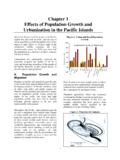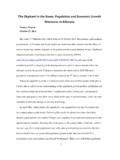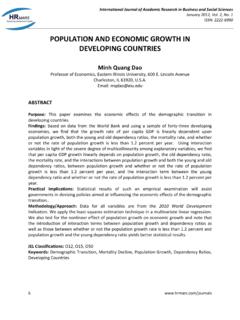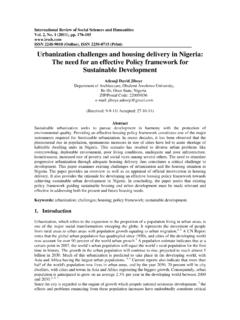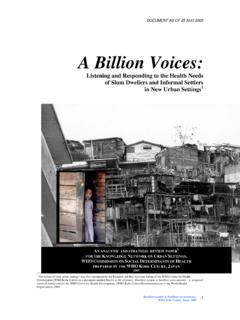Transcription of How to Feed the World in 2050 - Home | Food and ...
1 How to feed the World in 2050. Executive Summary 1. Introduction 2. Outlook for food security towards 2050. (1) The changing socio-economic environment (2) The natural resource base to 2050 will there be enough land, water and genetic diversity to meet demands? (3) Potential for food security 3. Prerequisites for global food security (1) Enhancing investment in sustainable agricultural production capacity and rural development (2) Promoting technology change and productivity growth (3) Trade, markets and support to farmers 4. The risks and challenges (1) Hunger amidst adequate overall supplies (2) Climate Change (3) Biofuels 5.
2 Mobilizing political will and building institutions 2. Executive Summary By 2050 the World 's population will reach billion, 34 percent higher than today. Nearly all of this population increase will occur in developing countries. Urbanization will continue at an accelerated pace, and about 70 percent of the World 's population will be urban (compared to 49 percent today). Income levels will be many multiples of what they are now. In order to feed this larger, more urban and richer population, food production (net of food used for biofuels) must increase by 70 percent.
3 Annual cereal production will need to rise to about 3 billion tonnes from billion today and annual meat production will need to rise by over 200 million tonnes to reach 470 million tonnes. This report argues that the required increase in food production can be achieved if the necessary investment is undertaken and policies conducive to agricultural production are put in place. But increasing production is not sufficient to achieve food security. It must be complemented by policies to enhance access by fighting poverty, especially in rural areas, as well as effective safety net programmes.
4 Total average annual net investment in developing country agriculture required to deliver the necessary production increases would amount to USD 83 billion. The global gap in what is required vis- -vis current investment levels can be illustrated by comparing the required annual gross investment of US$209 billion (which includes the cost of renewing depreciating investments) with the result of a separate study that estimated that developing countries on average invested USD 142 billion (USD of 2009) annually in agriculture over the past decade. The required increase is thus about 50 percent.
5 These figures are totals for public and private investment, investments by farmers. Achieving them will require a major reallocation in developing country budgets as well as in donor programmes. It will also require policies that support farmers in developing countries and encourage them and other private participants in agriculture to increase their investment. In developing countries, 80 percent of the necessary production increases would come from increases in yields and cropping intensity and only 20 percent from expansion of arable land. But the fact is that globally the rate of growth in yields of the major cereal crops has been steadily declining, it dropped from percent per year in 1960 to percent in 2000.
6 The challenge for technology is to reverse this decline, since a continuous linear increase in yields at a global level following the pattern established over the past five decades will not be sufficient to meet food needs. Although investment in agricultural R&D continues to be one of the most productive investments, with rates of return between 30 and 75 percent, it has been neglected in most low income countries. Currently, agricultural R&D in developing countries is dominated by the public sector, so that initially additional investment will have to come from government budgets.
7 Increasing private sector investment will require addressing issues of intellectual property rights while ensuring that a balance is struck so that access of smallholder farmers to new technologies is not reduced. Hunger can persist in the midst of adequate aggregate supplies because of lacking income opportunities for the poor and the absence of effective social safety nets. Experience of countries that have succeeded in reducing hunger and malnutrition shows that economic growth does not automatically ensure success, the source of growth matters too.
8 Growth originating in agriculture, in particular the smallholder sector, is at least twice as effective in 3. benefiting the poorest as growth from non-agriculture sectors. This is not surprising since 75. percent of the poor in developing countries live in rural areas and their incomes are directly or indirectly linked to agriculture. The fight against hunger also requires targeted and deliberate action in the form of comprehensive social services, including food assistance, health and sanitation, as well as education and training; with a special focus on the most vulnerable.
9 Many countries will continue depending on international trade to ensure their food security. It is estimated that by 2050 developing countries' net imports of cereals will more than double from 135 million metric tonnes in 2008/09 to 300 million in 2050. That is why there is a need to move towards a global trading system that is fair and competitive; and that contributes to a dependable market for food. Reform of farm support policies in OECD countries is a welcome step which has led to a decline in the aggregate trade distortion coefficient from in 1986 to in 2007.
10 However, there is clearly still room for improvement. There is also a need to provide support and greater market access to developing country farmers so that they can compete on a more equal footing. Countries also need to consider joint measures to be better prepared for future shocks to the global system, through coordinated action in case of food crises, reform of trade rules, and joint finance to assist people affected by a new price spike or localized disasters. Climate change and increased biofuel production represent major risks for long-term food security.










